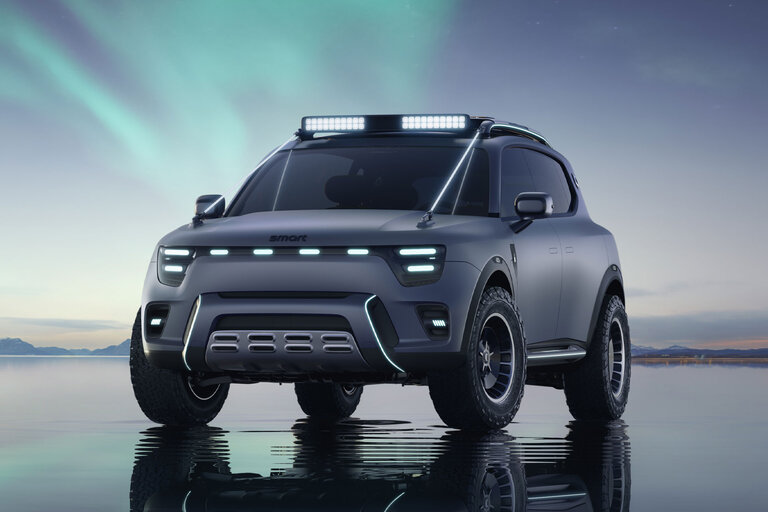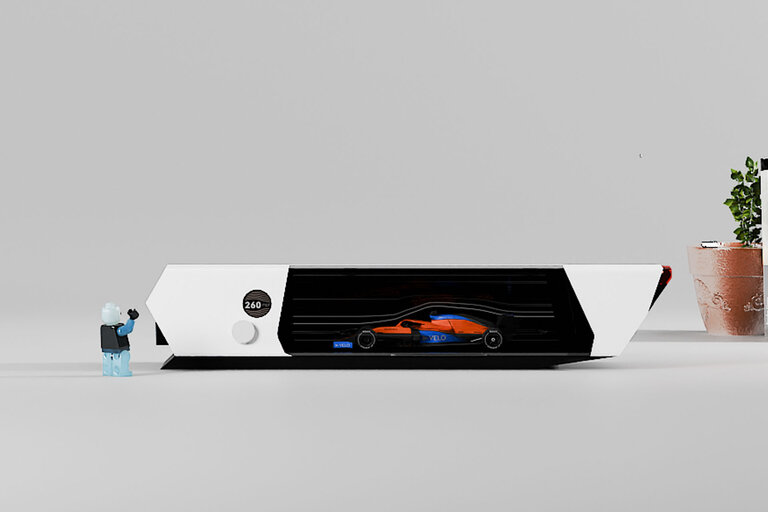
The holding tanks are the most daunting thing. If you’ve never stayed in an RV, the holding tanks loom large over your trip, because eventually they’ll need to be emptied. A little LED gadget in the bathroom will tell you when they’re empty, a third full, and so on. There are two tanks: one for grey water, from the shower and sink, and one for black water. That’s the toilet. But I’m getting ahead of myself. Emptying the tanks is the last thing you do before you return the RV. First you need to know where to start.
Your RV-rental decision tree has two main branches: what kind of RV to get, and where to go. On the former question, I’d recommend perusing GoRVing.com as a resource to explain the various genres of equipment, which can generally be classified as travel trailers or motor coaches. First-time renters tend to gravitate toward motor coaches on the theory that they’re self-contained and self-propelled, thus simpler, but that’s not necessarily the case.
Rule No. 1: You Need a Car
If you rent a travel trailer, congratulations: You’ll have a car (or rather, a truck or SUV) that you can uncouple and use for local transportation once you’ve arrived at your campsite. If you rent a motor coach, you’re probably going to need to enlist a spouse or friend to drive along with you in a personal vehicle, since your own car is not likely set up for flat-towing (you know, when you see some road behemoth that looks like it’s being tailgated by a driverless Wrangler). And why do you need a car? Because once you’ve set up your RV, that thing isn’t moving for a casual run for some flip-flops and an “I Love Clearwater” keychain. You’ll see.
No. 2: Rent Where You’re Going, Not Where You Live
I don’t have a particular preference for trailer over motor coach, or vice versa, but coaches are a little more versatile since they’re more compact than a truck-and-trailer combo. Some campsites are designated “Motor coach only” because they’re designed for nose-in parking, and the hookups are always on the left. On the other hand, a truck towing a trailer will probably be much nicer to drive than a motor coach. But that shouldn’t matter too much either way, because you definitely want your RV rental as close to your destination as possible.
I applied this rule to my recent trip from North Carolina—where I live—to St. Augustine, Florida. My local listings on Outdoorsy and RVShare had plenty of options, but why drag a 27-foot trailer 350 miles each way when I could find one within 15 minutes of the Ocean Grove RV resort? I know some people conceptualize highway RV travel as romantic, but trailers aren’t set up for passengers, and motor coaches aren’t great either. Almost all of them now have power slide-outs for extra space, which means that when they’re in travel mode, the interior is shrunk down to a narrow hallway between the kitchen and the couch. This isn’t the Almost Famous tour bus. Rent where you’re going, or at least minimize your mileage.
Rule No. 3: Know Your Site Before You Get There
This takes us back to the second major decision, the one concerning your destination. There are two paths you can go: boondocking or a resort. Boondocking means you find a spot to park and you’re totally self-contained—also what’s known as “living the dream.” If you’re boondocking, you can theoretically go anywhere, a hotel on wheels. I went boondocking a couple years ago, for a college reunion, and it was a genius move: I parked on the edge of a lot and had my own lodging for the weekend. Another time, I went that route at a NASCAR infield, and I’ve never had my abode any closer to a Sammy Hagar concert. The downside of boondocking is also that you’re totally self-contained. Whatever water is in your tank is what you’ve got for showers, sinks and the toilet. Electricity? You’d better have a generator. And as that water tank empties, the grey and black tanks fill up, and you can’t make like Cousin Eddie and dump them down a storm drain. Eventually, you’ll have to find a dump station (they’re at RV resorts, highway rest stops and outside NASCAR tracks). Boondocking is a finite thing—a weekend, easy on the showers.
Go to a resort, though, and you could live there. Plenty of people do. You’re hooked up to water and power, and you can empty your tanks whenever they get full. There might be a swimming pool, a bar, and a store. The demerit here is that a pad at an RV resort tends to be less idyllic than a boondocking scenario. RVs are oriented with the hookups on the driver’s side, and the door and awning on the passenger side, which means that most resort spots have your yard, as it were, hard against your neighbor’s back wall, with its hoses and cables. The setup gives everyone some privacy, but it’s not exactly scenic. So…
Rule 3(a): Find a Resort Spot that Doesn’t Border Another Space On the Passenger Side
That way you can have a view of something other than the side of somebody’s BuffCo Tarantula 32 gooseneck toy-hauler and its sewer hose.
My wife reserved just such at space at Ocean Grove: toward the back of the place, across from the boat ramp and looking out over the marshes. But since she booked the site and I booked the RV (through Outdoorsy) the fact that this space was a dead-end motor coach spot evaded both of us until it was too late to change anything. The resort told me that the site was probably big enough to pull in our tow rig (a 2021 Cadillac Escalade) and the 27-foot trailer I rented, with room to extract the SUV afterwards. Probably. If not? I’d just have to back it in and have our hookups on the wrong side. And our door facing the tiny house/mobile home to the left of us, instead of the water.
When we arrived at the RV owner’s house, at the outskirts of St. Augustine, the trailer was ready to go. The owner told me he’d listed the trailer, a KZ Sportsmen, on both Outdoorsy and RVShare (this seems like a common tactic—there’s lots of shared inventory) and it was booked regularly enough to pay for itself. “After you booked it, I had four more requests,” he said. After a quick tour, it was time to hitch up and head out.
I’m tempted to offer another rule here, to the effect that you should know your tow vehicle, but I’ll assume your tow rig is a known quantity. I’d brought my own hitch for the Escalade, but the owner wanted me to use his hitch, which raised the height of the ball at least eight inches. That’s because he normally towed with a Silverado 1500, and the tall hitch compensated for the rear suspension sag imposed by 750 pounds of tongue weight. I told him that the Escalade wouldn’t have that problem, by virtue of its air suspension, but I figured I should defer to the guy who tows this thing all the time and swapped in his hitch. As I predicted, the Escalade self-leveled and brought the trailer to an angle reminiscent of a speedboat climbing on plane, but I figured we were only driving about 10 miles, so it was fine. And it was, on the road.
After that came the hard part for the designated Keeper of the Camper: setting up. I’ve rented or tested a bunch of these things over the years, and they’re all a little bit different, with their own quirks and oddities. In this case, the good news was that the spot was big enough for me to pull in nose-first and still extract the Escalade, if I executed a 3000-point turn and didn’t fall into the Intracoastal. But that would assume I could separate it from the trailer.
Normally, you deploy a jack on the trailer and raise the coupler up off the ball. Simple. But since the nose of the Sportsmen was at monster truck height, the power-operated jack wouldn’t reach the ground. Then it died. At a loss, I got the notion to raise the Escalade’s suspension to off-road height, slide a block under the jack, then drop the Caddy to access height to release the hitch. But the Escalade wasn’t having it, displaying a “suspension overloaded” warning when I tried to go to off-road mode with the trailer attached.
Confounded, I resorted to calling the owner, who told me of a backup manual crank for the jack, stashed in a storage compartment. Using that and a stack of wooden blocks under the jack, I finally detached the Escalade and possibly cracked a beer.
Rule No. 4: Bring Rubber Gloves
After that, I lowered the stabilizing jacks and leveled everything, hooked up the water (just a garden hose and a spigot) and power, extended the power slide-out living room and deployed the awning. But there was one more thing to hook up, wasn’t there? That’s right, you’re going to hook up a sewer hose, and chances are it won’t be a new one. An RV sewer hose looks like a slinky—a stinky slinky—and often has a transparent window on the end that attaches to the RV, which this one did. Gross? Sure. But you want to be able to see what’s happening up there. The other side goes to what looks like a mere hole in the ground with a threaded fitting on top, but is presumably (hopefully) something more elaborate than that, beyond the business end. It’s all powered by gravity, which is why you see setups with elaborate spacers along the hose to maintain a downward slope from the RV to the hole in the ground.
This trailer had its own hose-flushing system, so the owner instructed me to use that after emptying the black tank. I probably should have stuck to my prior procedures on this front. Allow me to explain.
Rule No. 5: Just Keep the Damn Tank Valves Closed until They’re Full So You Can Use the Grey Water to Flush Out the Hose
What I did with the Sportsmen was open the grey water valve, so water from the shower and sink flowed freely out into the drain all weekend, instead of collecting in a big gravity-fed hose bomb that I have to think would work better than a rinsing system running off a garden hose. But we’ll get to that. Point is, no matter what, keep that black valve closed until the tank is full or you’re pulling up stakes.
All right, now we’re set to enjoy some RV’ing! I mean, as soon as you go buy the things you now realize you need, which will probably happen no matter how well you anticipate your RV’ing needs. Good thing you brought that car!
Rule No. 6: Ask the Owner Which Supplies Are Included and Be Very Specific
Each RV owner will have a different idea of what constitutes, “comes with everything you need,” which most will claim. Sometimes that’s actually true, and sometimes an owner will assume you’ll use disposable plates and utensils, so there won’t be any non-disposable versions of those. Definitely enquire about sheets and towels, pots and pans. Here’s a list to get you started:
- Rubber gloves (it bears repeating).
- Folding camp chairs.
- Charcoal briquettes, a lighter and grill tools. There’s usually an outdoor grill at resort spots.
- Coffee filters and maybe instant coffee, if it turns out there’s no coffeemaker.
- A few gallon-jugs of bottled water. The RV water is potable, but will taste like a garden hose, for obvious reasons.
- DVDs, since RVs usually have a DVD player.
- Earplugs and a sleep mask. You don’t know if the orientation of your spot will cause a laser sunbeam to hit your bedroom window at 5:30 am, or whether your neighbors might be up hootin’ and hollerin’ at … 5:30 am.
- Your own pillows. RV pillows are never great.
- RV-safe toilet paper. You buy this at the resort, but make sure there’s some included before you set off from the owner’s house.
All right, now enjoy your weekend or week or permanent vacation. Along the way, you’ll probably learn a few more things about your rented chalet. Like, I belatedly discovered that the Sportsmen’s audio system, which is connected to the DVD player, has two zones—indoor and outdoor—and I had both engaged during a boisterous evening showing of Austin Powers: The Spy Who Shagged Me. Whoops.
One other lesson: when a storm knocks out the power to an RV resort, that can cause the sewer system to back up something fierce because a lift pump goes offline. This is what financial types call a “black swan event” and I call “something I won’t discuss with you in greater detail except to say that I really wish I’d followed my own advice about the gloves when it came time to empty the black tank.”
Even with that unfortunate denouement, a good time was had. The kids spent a weekend riding bikes around the resort, they played basketball and went to the pool; we hit the beach and Ripley’s Believe it or Not museum. I grilled dinner as the sun set over the marsh and we watched movies at night. And when we were done, I took advantage of another perk you can often find on Outdoorsy listings: free delivery and pick up. I’d wanted to set up the RV myself, but when it came time to leave, we packed our bags, emptied the tanks and hit the road. The Outdoorsy deal seems like a win-win for everyone—the RV owner makes some money that helps offset the cost of the thing, and the renter gets the RV experience without the commitment of buying one. I’ll do it again. I’m due for some boondocking.
This content is created and maintained by a third party, and imported onto this page to help users provide their email addresses. You may be able to find more information about this and similar content at piano.io
Source link














